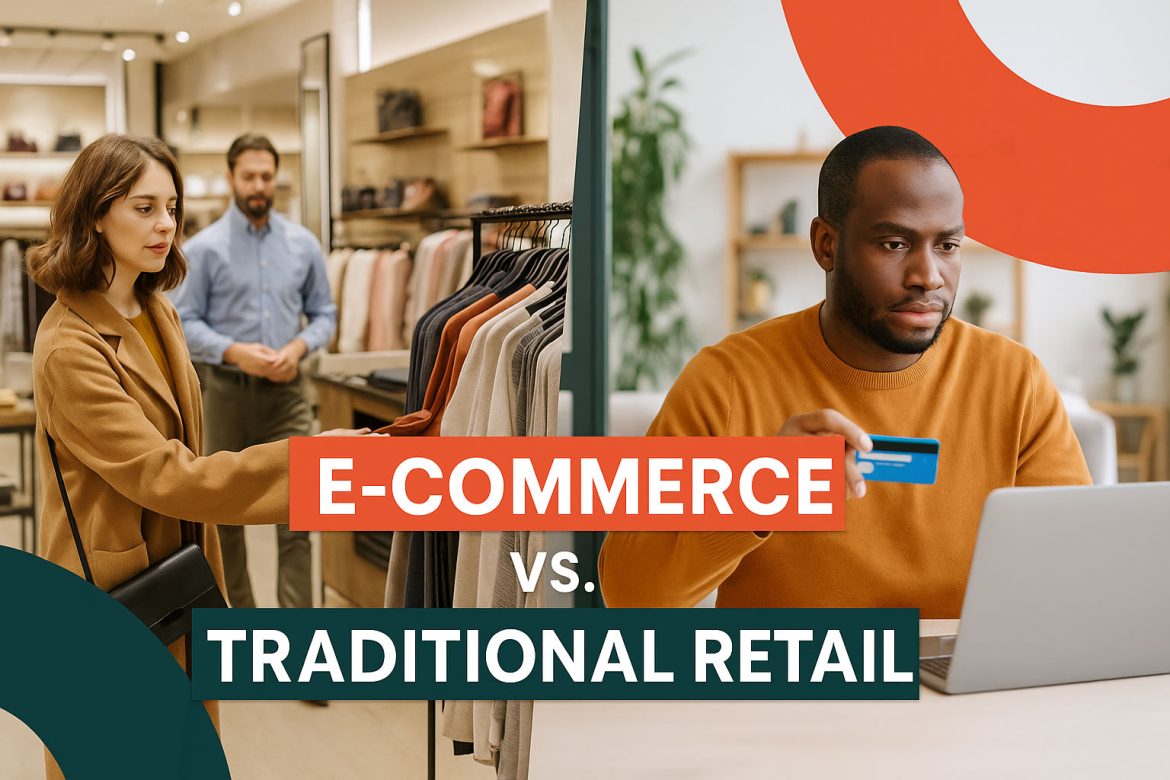Introduction: A Marketplace in Transition
The commerce world is undergoing its most dramatic shift since the industrial revolution. While the rise of e-commerce in the early 2000s appeared to signal an inevitable decline in traditional retail, the story has proven more complex—and more competitive.
Brick-and-mortar retail did not vanish. In fact, it evolved. Physical stores became showrooms, pickup points, and experiential hubs. At the same time, e-commerce giants moved offline—Amazon launched physical bookstores, while digital-first brands opened flagship locations. These developments prompt a fundamental question:
Which model—e-commerce or traditional retail—is better positioned to dominate the next decade?
This essay dissects the strengths, weaknesses, and trajectories of both sectors through the lenses of technology, consumer behavior, logistics, experience, and economics. It then proposes an outcome not defined by a single victor—but by the adaptive strength of hybrid innovation.
Section I: Strengths and Limitations – A Comparative Baseline
🛒 E-Commerce: The Digital Powerhouse
Strengths:
- Scalability without real estate: Digital stores reach global audiences without geographic limitations.
- Data-rich operations: Every click, view, or scroll creates a measurable behavior trail.
- 24/7 availability: Shopping is no longer bound by time or place.
- Inventory efficiency: Centralized warehouses reduce the need for distributed inventory.
Limitations:
- Logistics complexity and rising costs
- Higher return rates (20%–30%) due to misfit or dissatisfaction
- Limited sensory experience (no trying, feeling, or testing)
- Heavy competition and ad spend inflation on platforms like Google and Meta
🏬 Traditional Retail: The Physical Stronghold
Strengths:
- Tactile experience: Products can be seen, touched, tested in real-time.
- Instant gratification: No shipping delay—customers leave with the product.
- In-person service: Sales associates guide, upsell, and build trust.
- Brand immersion: Physical presence builds stronger sensory identity.
Limitations:
- Fixed operating hours and locations
- Higher overhead (rent, staff, utilities)
- Limited stock per location
- Susceptibility to foot traffic decline and economic shocks
Section II: Consumer Behavior Trends — What Shoppers Want in 2025
Omnichannel Expectations Have Become Standard.
Shoppers no longer think in terms of “online” vs. “offline.” They begin their journey on Instagram, check prices on a mobile app, and complete their purchase in-store—or vice versa. The winning model is determined by the seamlessness of this transition.
Key Behavior Drivers in 2025:
- Mobile-first commerce: Over 70% of global e-commerce traffic is now mobile.
- Experience as currency: Consumers seek engaging, personalized, immersive brand interactions.
- Sustainability and trust: Shoppers care where, how, and from whom they buy.
- Frictionless fulfillment: Options like BOPIS (Buy Online, Pick Up In Store), curbside pickup, and 2-hour delivery are expected.
💬 “Consumers don’t choose channels—they choose convenience, trust, and experience.”
Section III: The Tech Factor – Who Holds the Edge?
For E-Commerce:
- AI-powered recommendations and personalization outperform manual upselling.
- Augmented reality (AR) enables virtual try-ons and product visualization.
- Chatbots and virtual assistants handle real-time customer service at scale.
- Predictive analytics inform marketing, pricing, and supply chain planning.
For Retail:
- Smart mirrors, RFID tags, and in-store sensors create data-driven experiences.
- Mobile POS systems remove checkout friction.
- Facial recognition and behavior tracking offer offline personalization.
Edge:
While e-commerce leads in data and automation, traditional retail is rapidly closing the gap through in-store digital transformation.
Section IV: Economic and Market Forces
The future of commerce will also be influenced by external forces:
Inflation and Cost of Living:
- E-commerce faces challenges with rising fulfillment and return costs.
- Traditional retail struggles with rising rent and labor costs.
Urbanization and Real Estate:
- Pop-up shops and flexible leasing favor agile retail models.
- Warehousing demand has surged—good for e-commerce, but strained by zoning and logistics infrastructure.
Platform Dependence:
- E-commerce businesses are often at the mercy of changing algorithms (Meta, Google, Amazon).
- Traditional retailers are more exposed to shifts in local foot traffic and economic downturns.
Section V: Case Examples — Signals from the Market
Example 1: Nike
Nike has aggressively pursued a direct-to-consumer hybrid model:
- Closed hundreds of retail partners
- Launched immersive brand stores
- Invested in SNKRS app, AR try-ons, and personalized mobile content
Lesson: Blending physical immersion with digital convenience leads to brand control and customer retention.
Example 2: Shopify
Shopify merchants are increasingly building offline extensions—opening showrooms and pop-ups, attending local fairs, and hosting brand events.
Lesson: Digital-first brands are leveraging physical space for trust and deeper engagement.
Example 3: Target
Target’s success lies in omnichannel execution:
- Strong app-based ordering
- Efficient curbside pickup
- Visually optimized stores for modern experience
Lesson: Traditional retail, when reimagined with tech and convenience, remains a powerful model.
Section VI: Predictions – What the Next Decade Holds
❯ Prediction 1: The Rise of Experiential Retail
Traditional stores will become experiential destinations—not just sales points. Expect immersive brand theaters, co-creation labs, and community-driven retail.
❯ Prediction 2: E-Commerce Will Integrate Deeper Offline
More digital brands will invest in micro-locations, same-day delivery depots, and logistics-as-a-service to improve physical presence without the full cost of retail.
❯ Prediction 3: AI Will Erase the Channel Divide
As artificial intelligence integrates further, the distinction between digital and physical will blur. AI will power personalization in-store just as it does online—merging the best of both.
❯ Prediction 4: Value Will Overtake Channel Loyalty
Shoppers won’t favor e-commerce or retail by default. They’ll favor value-rich ecosystems—those that offer convenience, ethics, experience, and affordability across all touchpoints.
Final Analysis: Is There a Winner?
If by “winner,” we mean dominance, then neither will monopolize. But if we define winning as relevance, adaptability, and consumer trust, then hybrid commerce will lead.
The model that wins will be:
- Channel-fluid: adapting content, logistics, and service across touchpoints
- Data-literate: using insights from both physical and digital to optimize journeys
- Experience-led: placing emotional engagement above transactional convenience
- Operationally agile: capable of expanding or contracting across regions and formats
Closing Thought
“The next decade won’t be about e-commerce replacing retail, or vice versa. It will be about how seamlessly you move between them.”
In the race between pixels and pavement, it’s not either/or. It’s both—and how well a brand harmonizes them that will define the leaders of 2035.




